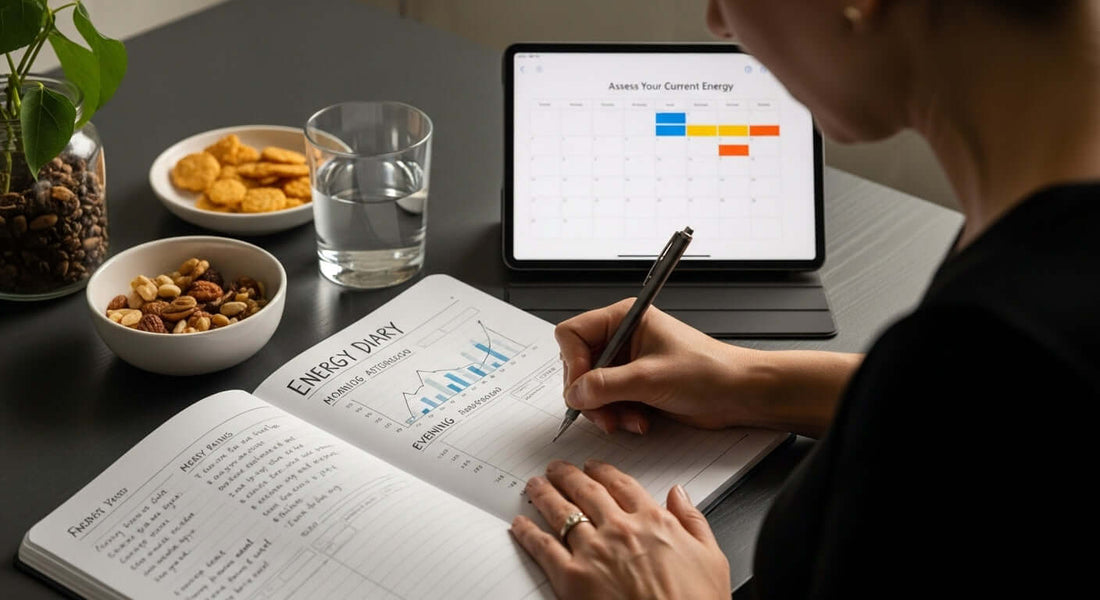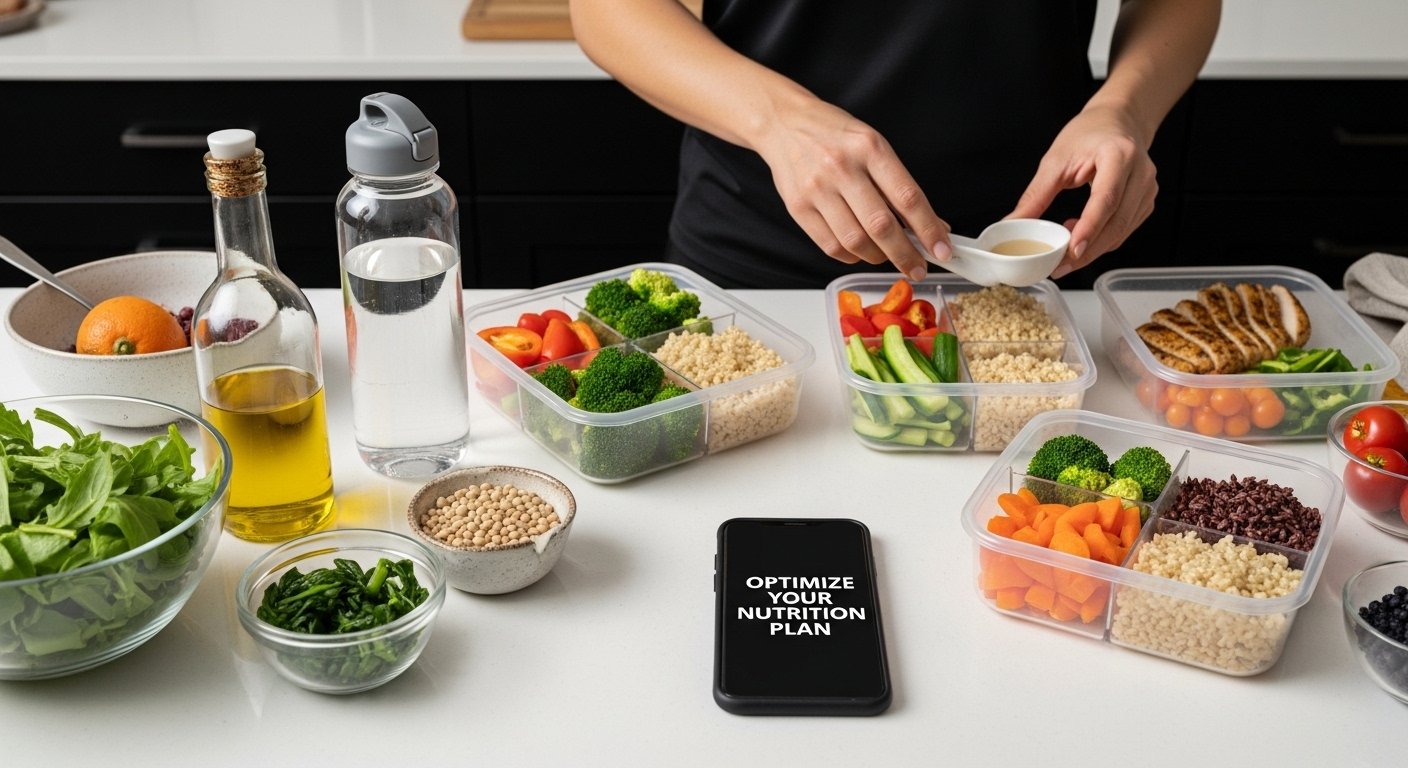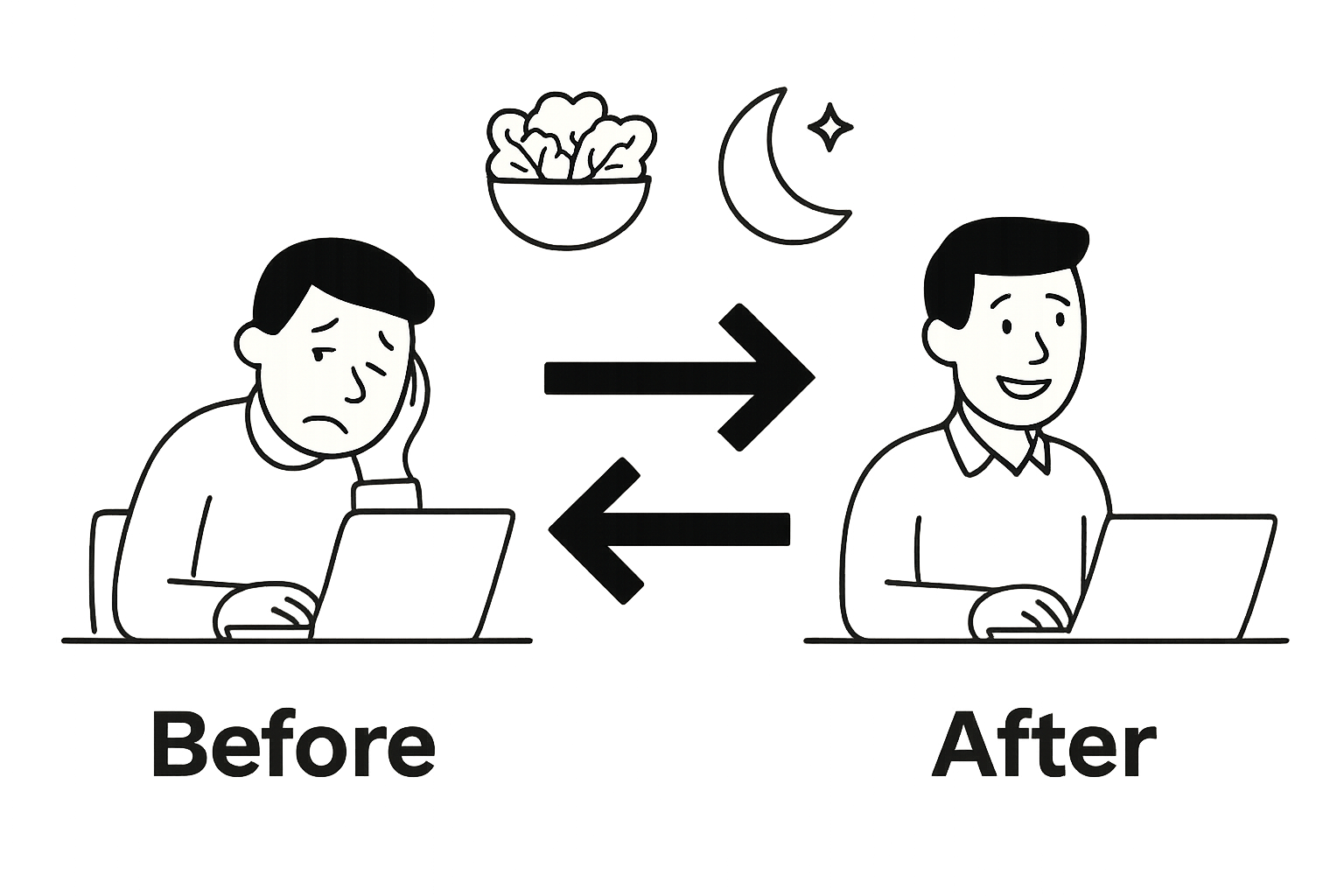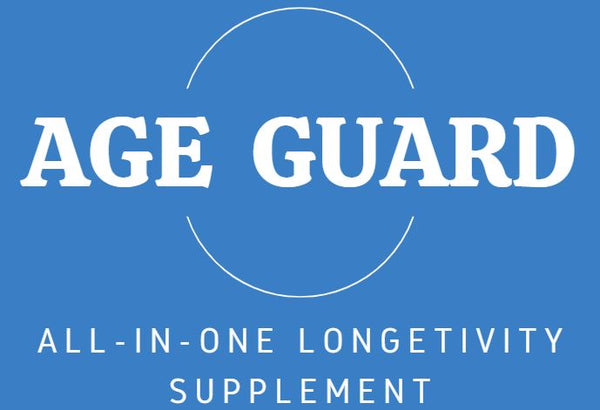
How to Increase Energy After 30: Boost Vitality Naturally
Share
Most people notice their energy takes a hit after 30 and think it is just part of getting older. But recent studies show that deficiencies in key nutrients like Vitamin D, B12, and iron affect as many as 40 percent of adults over 30, often leading to unnecessary fatigue. So the real surprise is that small lifestyle changes can unlock energy you thought was gone for good.
Table of Contents
- Step 1: Assess Your Current Energy Levels
- Step 2: Optimize Your Nutrition Plan
- Step 3: Incorporate Regular Exercise Routines
- Step 4: Prioritize Quality Sleep Habits
- Step 5: Manage Stress Through Mindfulness Techniques
- Step 6: Evaluate and Adjust Your Progress
Quick Summary
| Key Point | Explanation |
|---|---|
| 1. Track your energy levels daily | Maintain an energy diary for a week to assess fluctuations and identify patterns impacting vitality. |
| 2. Focus on nutrient-dense foods | Prioritize whole, unprocessed foods to support energy levels and metabolic efficiency. |
| 3. Incorporate regular strength training | Utilize resistance exercises 2-3 times a week to combat muscle loss and enhance vitality. |
| 4. Establish a consistent sleep routine | Aim for 7-9 hours of quality sleep and maintain a regular sleep schedule for optimal recovery. |
| 5. Use mindfulness for stress management | Integrate mindfulness techniques like meditation to reduce stress and preserve energy reserves. |
Step 1: Assess Your Current Energy Levels
Understanding your current energy baseline is crucial for developing an effective strategy to boost vitality after 30. This initial assessment provides a roadmap for targeted improvements, helping you identify specific areas where your energy might be lagging.
Start by creating a comprehensive energy diary that tracks your daily energy fluctuations. For one week, document your energy levels from morning to evening, noting factors like sleep quality, stress, nutrition, physical activity, and overall mood. Rate your energy on a scale of 1-10 at different times of the day, paying special attention to natural peaks and dips.
Consult with a healthcare professional to rule out underlying medical conditions that might be impacting your energy. Johns Hopkins Medicine recommends comprehensive blood work to check critical markers like:
- Vitamin D levels
- Thyroid function
- Hormone balance
- Iron and B12 concentrations
These tests can reveal hidden factors contributing to fatigue that aren’t immediately apparent through self-assessment. Deficiencies in these areas are common after 30 and can significantly drain your energy reserves.
Reflect on your lifestyle patterns and identify potential energy zappers. Common culprits include inconsistent sleep schedules, poor nutrition, sedentary behaviors, chronic stress, and inadequate hydration. Look for patterns in your energy diary that correlate with specific activities or lifestyle choices.
Your goal is to create a clear, objective snapshot of your current energy landscape. By meticulously documenting and analyzing your daily experience, you’ll gain valuable insights that will inform personalized strategies to naturally enhance your vitality. This foundational step transforms vague feelings of fatigue into actionable intelligence for targeted improvement.
Step 2: Optimize Your Nutrition Plan
Nutrition plays a pivotal role in maintaining and boosting energy levels after 30. Your dietary choices can dramatically influence your metabolic efficiency, cellular health, and overall vitality. This step focuses on transforming your eating habits to create a sustainable energy blueprint that supports your body’s changing needs.
Begin by reimagining your plate as a strategic energy management tool. MyPlate.gov recommends creating balanced meals that incorporate diverse nutrient groups. Focus on whole, unprocessed foods that provide sustained energy release. This means prioritizing complex carbohydrates, lean proteins, healthy fats, and abundant vegetables that deliver steady nutrition without dramatic blood sugar spikes.
Design a meal strategy that emphasizes protein-rich foods consumed throughout the day. Include sources like wild-caught fish, grass-fed meats, eggs, legumes, and plant-based proteins that support muscle maintenance and metabolic function. These proteins help stabilize energy levels and prevent the mid-afternoon crash commonly experienced after 30.
Implement a strategic hydration and meal timing approach. Consume smaller, more frequent meals to maintain consistent energy. Aim for:
- A nutritious breakfast within one hour of waking
- Balanced meals every 3-4 hours
- Protein and complex carbohydrate combinations
- Minimal processed sugar and refined carbohydrates
Pay special attention to micronutrient density. As metabolism naturally slows with age, each calorie becomes more critical. Incorporate nutrient-dense foods like leafy greens, berries, nuts, seeds, and fermented vegetables that provide essential vitamins, minerals, and antioxidants. These foods support cellular repair, reduce inflammation, and enhance overall energy production.
Track your nutritional impact by monitoring how different foods affect your energy levels.
 Keep a detailed food journal noting meal compositions, energy responses, and any physical changes. This personalized approach allows you to fine-tune your nutrition plan, creating a customized strategy that addresses your unique metabolic needs and supports sustained vitality.
Keep a detailed food journal noting meal compositions, energy responses, and any physical changes. This personalized approach allows you to fine-tune your nutrition plan, creating a customized strategy that addresses your unique metabolic needs and supports sustained vitality.
Step 3: Incorporate Regular Exercise Routines
Exercise becomes increasingly critical after 30, serving as a powerful intervention to maintain energy, metabolic health, and overall vitality. Your approach must be strategic, progressive, and tailored to your current fitness level, focusing on sustainable movement that supports both physical and mental well-being.
Fundamental fitness requires a multifaceted approach that balances cardiovascular endurance, strength training, flexibility, and recovery. Start by establishing a baseline fitness routine that includes a mix of low-impact and moderate-intensity exercises. This strategy prevents injury while gradually building strength and stamina.
CDC Physical Activity Guidelines recommend at least 150 minutes of moderate aerobic activity or 75 minutes of vigorous activity weekly. Break this down into manageable segments: 30-minute sessions five days a week or shorter 15-minute intervals that fit more easily into a busy schedule. Walking, swimming, cycling, and dance-based fitness classes offer excellent low-impact options that minimize joint stress while maximizing metabolic engagement.
Strength training becomes exponentially more important after 30. Muscle mass naturally declines with age, making resistance exercises crucial for maintaining metabolism, bone density, and overall functional strength. Incorporate bodyweight exercises, resistance bands, or light weights 2-3 times weekly. Focus on compound movements that engage multiple muscle groups simultaneously:
- Squats with shoulder presses
- Lunges with bicep curls
- Planks with rotation
- Push-ups with modified variations
Create a flexible exercise framework that adapts to your energy levels and schedule. Some days might allow for intense workouts, while others require gentler movement. Listen to your body, prioritizing consistency over intensity. Track your progress through simple metrics like workout frequency, perceived exertion, and recovery time.
Mindful movement practices like yoga and Pilates complement traditional exercise routines, offering flexibility, core strength, and stress reduction. These practices enhance body awareness, improve breathing patterns, and support overall energy management. By integrating diverse movement strategies, you create a holistic approach to maintaining vitality and resilience after 30.
Below is a summary table of recommended exercise types, frequency, and benefits to help guide your regular fitness routine after 30.
| Exercise Type | Recommended Frequency | Example Activities | Key Benefits |
|---|---|---|---|
| Cardio/Aerobic | 150 min/week (moderate) | Walking, swimming, cycling | Enhances heart health, boosts energy |
| Strength Training | 2-3 times per week | Bodyweight, weights, resistance | Maintains muscle mass, metabolism |
| Flexibility | Include in each session | Yoga, stretching, Pilates | Improves mobility, reduces injury |
| Mindful Movement | 1-3 times per week | Yoga, tai chi, walking meditation | Supports stress relief, flexibility |
Step 4: Prioritize Quality Sleep Habits
Sleep transforms from a passive recovery process to a critical performance optimization strategy after 30. Your body’s ability to regenerate, repair cellular damage, and maintain metabolic efficiency depends heavily on consistent, high-quality sleep. This step focuses on creating a comprehensive sleep architecture that supports sustained energy and overall vitality.
Establish a non-negotiable sleep routine that respects your body’s natural circadian rhythms. Consistency is key - aim to go to bed and wake up at the same time every day, even on weekends. This regularity helps synchronize your internal biological clock, improving both sleep quality and daytime energy levels. Create a dedicated wind-down period 60-90 minutes before bedtime, signaling to your body that it’s time to transition into rest mode.
Centers for Disease Control and Prevention recommends 7-9 hours of sleep for optimal health. Transform your bedroom into a sleep sanctuary by controlling environmental factors. Maintain a cool room temperature between 60-67 degrees Fahrenheit, use blackout curtains to eliminate light pollution, and invest in a high-quality mattress and pillows that support proper spinal alignment.
Develop a sophisticated sleep preparation ritual that begins well before bedtime. This includes:
- Avoiding electronic screens 1 hour before sleep
- Limiting caffeine intake after 2 PM
- Practicing relaxation techniques like deep breathing
- Creating a calm, quiet sleeping environment
Recognize that sleep quality trumps sleep quantity. Focus on achieving deep, restorative sleep cycles rather than simply logging hours in bed. Implement strategies like reducing evening blue light exposure, using blue light filtering glasses, and creating a calm pre-sleep routine that helps your nervous system transition into relaxation mode.
Track your sleep patterns using wearable technology or sleep tracking apps. Monitor metrics like total sleep time, sleep cycles, and morning energy levels. This data provides insights into your sleep quality and helps you make targeted improvements. By treating sleep as an active, intentional process, you’ll unlock a powerful mechanism for maintaining energy and resilience after 30.
Use this table as a checklist to help build your personal sleep improvement plan and ensure all critical components for sleep quality are addressed.
| Sleep Habit | Description | Action Item Example |
|---|---|---|
| Consistent Schedule | Go to bed and wake up same time daily | Set a fixed bedtime/alarm |
| Sleep Environment | Maintain cool, dark, quiet room | Install blackout curtains |
| Pre-Bed Routine | Establish wind-down activities | Read, stretch, or meditate |
| Screen Limitation | Reduce electronic device use before sleep | Avoid screens 1 hour pre-bed |
| Caffeine Management | Limit caffeine intake in the afternoon | No coffee after 2 PM |
| Track Sleep | Monitor patterns with apps or wearables | Use a sleep tracking app |
Step 5: Manage Stress Through Mindfulness Techniques
Stress management becomes increasingly critical after 30, as your body’s natural resilience begins to change. Mindfulness techniques offer a powerful approach to neutralizing chronic stress, protecting your energy reserves, and maintaining mental and physical vitality. This step transforms stress from an energy-depleting force into an opportunity for personal growth and emotional regulation.
Develop a personalized stress management framework that integrates multiple mindfulness practices. Begin by recognizing stress triggers and creating intentional interruption patterns. This means establishing immediate response strategies when you feel tension building. Deep breathing exercises, which can be performed anywhere, serve as your first line of defense. Practice diaphragmatic breathing by inhaling deeply through your nose for four counts, holding for two, and exhaling slowly through your mouth for six counts.
International Journal of Environmental Research and Public Health research confirms that consistent mindfulness interventions significantly reduce stress and improve psychological well-being. Implement a daily meditation practice, starting with just 5-10 minutes and gradually increasing duration. Use guided meditation apps or online resources to support your practice, making it more accessible and structured.
Create a comprehensive stress management toolkit that includes multiple techniques:
- Morning mindfulness meditation
- Midday breathing reset
- Evening journaling
- Progressive muscle relaxation
- Visualization techniques
Integrate movement-based mindfulness practices like yoga, tai chi, or walking meditation. These approaches combine physical activity with mental centering, providing dual benefits of stress reduction and gentle exercise. Choose practices that resonate with your personal preferences and lifestyle, ensuring long-term consistency.
Track your stress levels and mindfulness progress through a dedicated journal. Record daily stress intensity, emotional states, and the effectiveness of your chosen techniques. This reflective practice helps you refine your approach, identifying which strategies provide the most significant relief. Remember that mindfulness is a skill developed through consistent practice, with benefits accumulating over time. Approach this journey with patience, curiosity, and self-compassion.
Step 6: Evaluate and Adjust Your Progress
Progressively tracking and adapting your energy optimization strategy becomes essential after 30, when metabolic changes require more intentional and personalized approaches. This final step transforms your initial efforts into a dynamic, responsive system that continuously evolves with your changing physiological needs.
Create a comprehensive tracking system that captures multiple dimensions of your energy and wellness journey. Develop a detailed journal or digital dashboard that records key metrics including daily energy levels, sleep quality, exercise performance, nutrition intake, stress indicators, and overall subjective well-being. Use technology like fitness trackers, smartphone apps, or specialized health monitoring platforms to streamline data collection and provide objective insights.
StatPearls highlights the importance of personalized behavior modification, emphasizing that successful lifestyle interventions must be tailored to individual characteristics and circumstances. Schedule monthly self-assessment sessions where you review your collected data, identifying patterns, progress, and potential areas for refinement.
Establish clear, measurable indicators of success that go beyond traditional metrics:
- Consistent energy levels throughout the day
- Reduced afternoon fatigue
- Improved mood and mental clarity
- Enhanced physical performance
- Better stress management
Be prepared to make strategic adjustments based on your findings. If certain nutrition strategies aren’t delivering expected results, consult a nutritionist. If exercise routines feel monotonous or ineffective, work with a fitness professional to redesign your approach. Recognize that your body’s requirements will continue to change, demanding ongoing curiosity and adaptability.
Approach this evaluation process with compassion and scientific curiosity. Your goal isn’t perfection but continuous improvement. Celebrate incremental progress, understanding that sustainable energy optimization is a journey of consistent, intentional choices.
 By maintaining a flexible, data-driven mindset, you’ll develop a personalized system that supports your vitality and well-being through the decades ahead.
By maintaining a flexible, data-driven mindset, you’ll develop a personalized system that supports your vitality and well-being through the decades ahead.
Unlock Lasting Energy After 30 with a Clinically-Backed Solution
If you are seeking ways to increase energy after 30, you know how frustrating it can feel when better sleep, clean nutrition, and optimal exercise routines only partially solve sluggishness and low vitality. Often, your body needs support at the cellular level, especially as natural nutrient absorption and cellular repair processes decline with age. The article above highlights how tracking energy, optimizing nutrition, and building new habits can help, but sometimes these foundational steps do not address deeper biological changes driving fatigue and slow recovery.

Ready to take your progress further? The specialized formula in Age Guard targets key areas like cellular energy, healthy aging, and curveball nutrient deficiencies that are common after 30. With research-backed dosages of NMN, collagen, spermidine, and powerful antioxidants, Age Guard is designed specifically for adults who want a real advantage in keeping energy levels consistent throughout the day. Visit MyAgeGuard.com now to learn more about the product, dive into clinical research and customer reviews, and get access to exclusive subscription discounts. Turn your commitment to increased vitality into long-term transformation—start your Age Guard journey today.
Frequently Asked Questions
How can I assess my current energy levels effectively?
Start by creating an energy diary to track your daily energy fluctuations for one week. Document factors like sleep quality, stress, nutrition, and activity levels, and rate your energy from 1-10 at different times of the day.
What nutritional changes can help boost energy after 30?
Focus on balanced meals that incorporate whole, unprocessed foods. Prioritize complex carbohydrates, lean proteins, healthy fats, and plenty of vegetables. Aim for smaller, frequent meals to maintain consistent energy levels throughout the day.
What exercise routine is recommended for increasing energy after 30?
Incorporate a mix of cardiovascular exercises, strength training, and flexibility workouts. Aim for at least 150 minutes of moderate aerobic activity weekly and include resistance training 2-3 times per week to maintain muscle mass and metabolic health.
How can I improve my sleep quality for better energy levels?
Establish a consistent sleep routine by going to bed and waking up at the same times daily. Create a relaxing wind-down period before bed, limit screen time, and ensure a comfortable sleep environment to promote restorative sleep.
